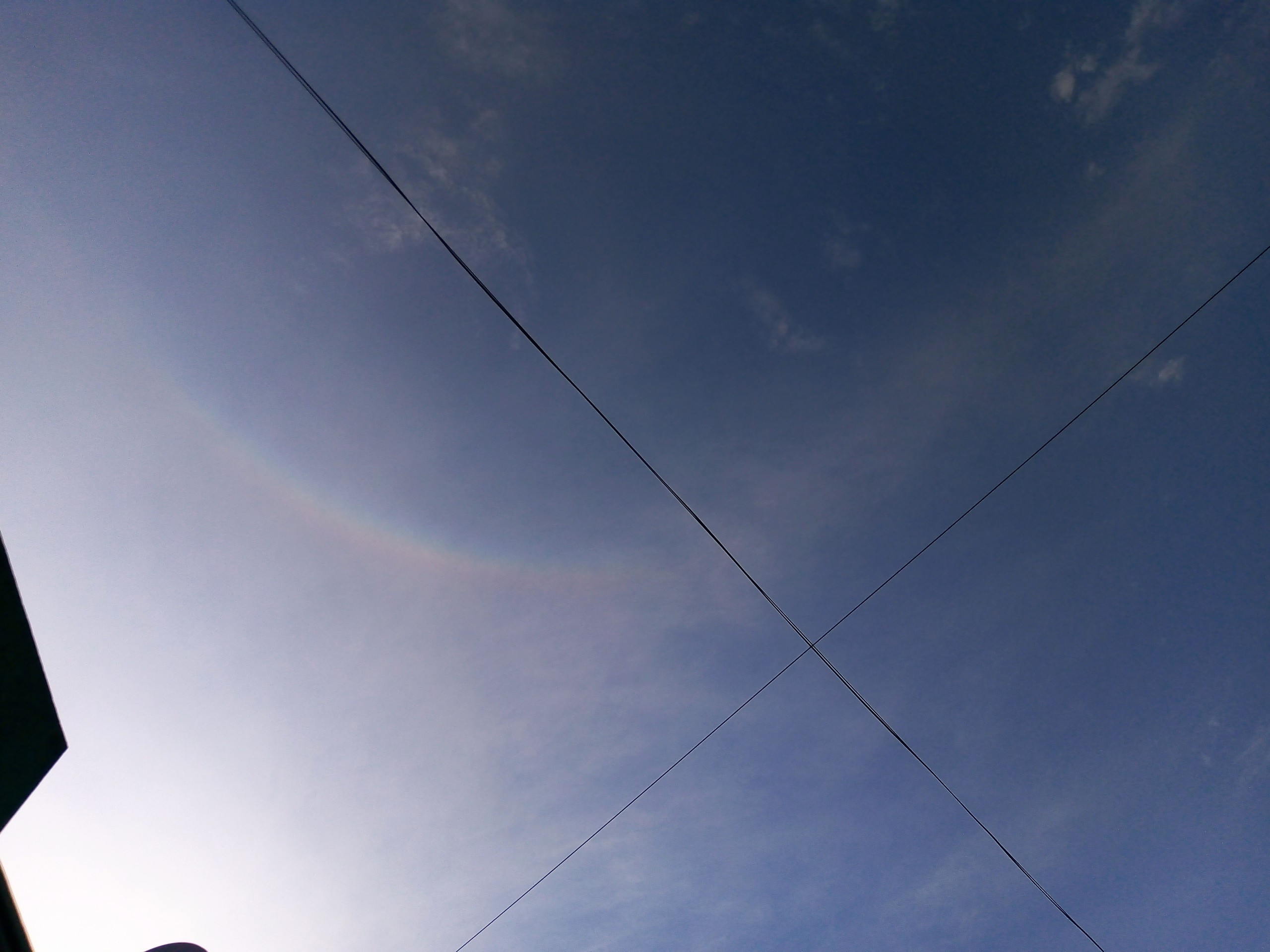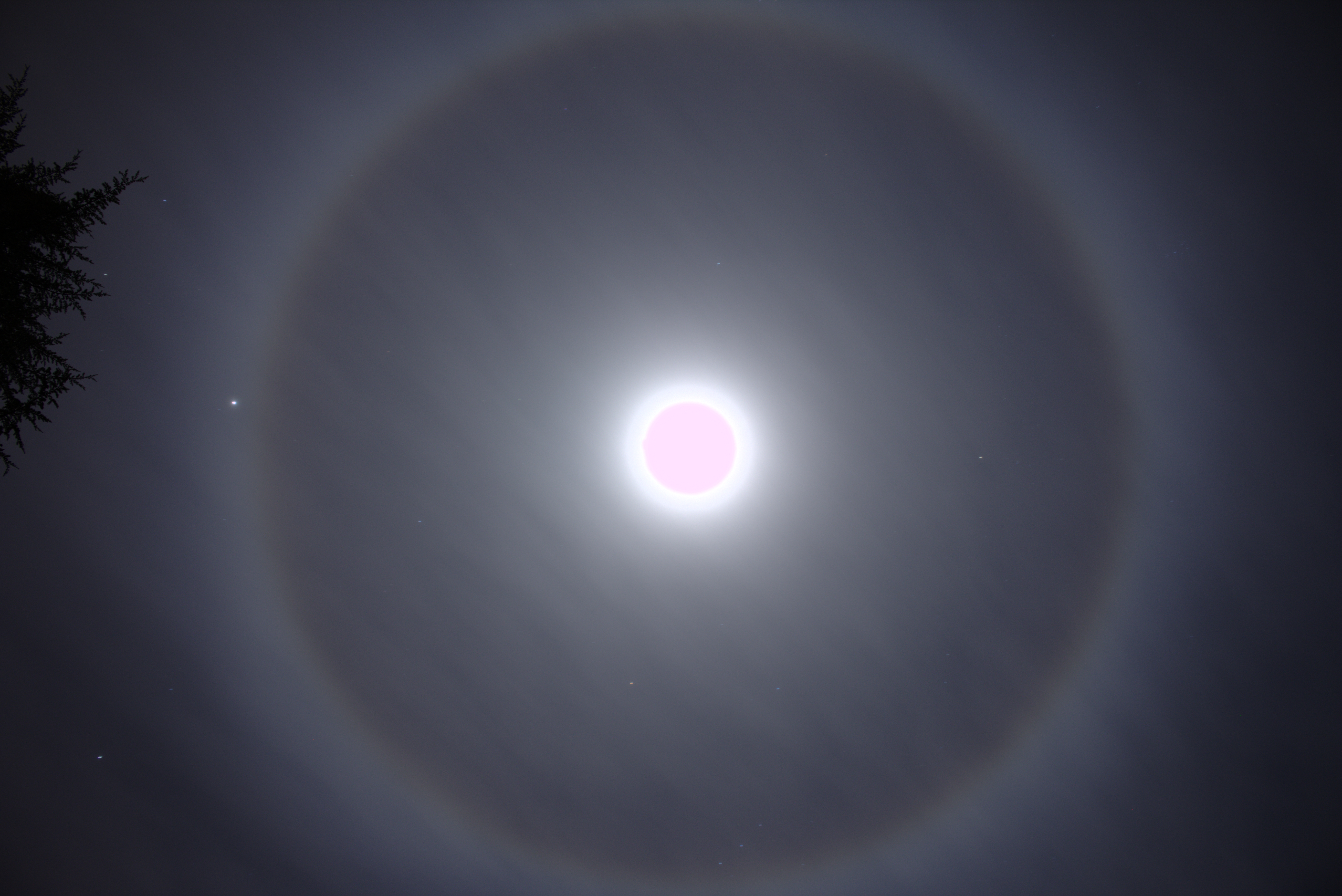|
Infralateral Arc
An infralateral arc (or lower lateral tangent arc) is a rare halo, an optical phenomenon appearing similar to a rainbow under a white parhelic circle. Together with the supralateral arc they are always located outside the seldom observable 46° halo, but in contrast to supralateral arcs, infralateral arcs are always located below the parhelic circle. The shape of an infralateral arc varies with the elevation of the Sun. Between sunrise and before the observed Sun reaches about 50° over Earth's horizon, two infralateral arcs are located on either side (e.g. lateral) of the 46° halo, their convex apexes lying tangent to the 46° halo. As the observed Sun reaches above 68° the two arcs unite to a single concave arc tangent to the 46° halo vertically under the Sun. (Including a photo from January 1996 and a 1980 computer simulation of infra- and supralateral arcs relative to a 46° halo.) Infralateral arcs form when sunlight enters horizontally oriented, rod-shaped hexagona ... [...More Info...] [...Related Items...] OR: [Wikipedia] [Google] [Baidu] |
Halo (optical Phenomenon)
A halo is an optical phenomenon produced by light (typically from the Sun or Moon) interacting with ice crystals suspended in the atmosphere. Halos can have many forms, ranging from colored or white rings to arcs and spots in the sky. Many of these appear near the Sun or Moon, but others occur elsewhere or even in the opposite part of the sky. Among the best known halo types are the circular halo (properly called the 22° halo), light pillars, and sun dogs, but many others occur; some are fairly common while others are extremely rare. The ice crystals responsible for halos are typically suspended in cirrus or cirrostratus clouds in the upper troposphere (), but in cold weather they can also float near the ground, in which case they are referred to as diamond dust. The particular shape and orientation of the crystals are responsible for the type of halo observed. Light is reflected and refracted by the ice crystals and may split into colors because of dispersion. The ... [...More Info...] [...Related Items...] OR: [Wikipedia] [Google] [Baidu] |
Prism (optics)
An optical prism is a transparent optical element with flat, polished surfaces that are designed to refract light. At least one surface must be angled — elements with two parallel surfaces are ''not'' prisms. The most familiar type of optical prism is the triangular prism, which has a triangular base and rectangular sides. Not all optical prisms are geometric prisms, and not all geometric prisms would count as an optical prism. Prisms can be made from any material that is transparent to the wavelengths for which they are designed. Typical materials include glass, acrylic and fluorite. A dispersive prism can be used to break white light up into its constituent spectral colors (the colors of the rainbow) as described in the following section. Other types of prisms noted below can be used to reflect light, or to split light into components with different polarizations. Types Dispersive ''Dispersive prisms'' are used to break up light into its constituent spectral col ... [...More Info...] [...Related Items...] OR: [Wikipedia] [Google] [Baidu] |
Parry Arc
A Parry arc is a rare halo, an optical phenomenon which occasionally appears over a 22° halo together with an upper tangent arc. Discovery The halo was first described by Sir William Edward Parry (1790–1855) in 1820 during one of his Arctic expeditions in search for the Northwest Passage. On April 8, under harsh conditions while his two ships were trapped by ice forcing him to winter over at Melville Island in the northern Canadian Arctic Archipelago, he made a drawing of the phenomenon. The drawing accurately renders the parhelic circle, a 22° halo, a pair of sun dogs, a lower tangent arc, a 46° halo, and a circumzenithal arc. He did, however, get the upper tangent arc slightly wrong. On the other hand, he added two arcs extending laterally from the bases of the 46° halo, for long interpreted as incorrectly drawn infralateral arcs, but were probably correctly drawn subhelic arcs (both produced by the same crystal orientation but with light passing through differe ... [...More Info...] [...Related Items...] OR: [Wikipedia] [Google] [Baidu] |
Tangent Arc
Tangent arcs are a type of halo, an atmospheric optical phenomenon, which appears above and below the observed Sun or Moon, tangent to the 22° halo. To produce these arcs, rod-shaped hexagonal ice crystals need to have their long axis aligned horizontally. Description Upper arc The shape of an upper tangent arc varies with the elevation of the Sun; while the Sun is low (less than 29–32°) it appears as an arc over the observed Sun forming a sharp angle. As the Sun is seen to rise above the Earth's horizon, the curved wings of the arc lower towards the 22° halo while gradually becoming longer. As the Sun rises over 29–32°, the upper tangent arc unites with the lower tangent arc to form the circumscribed halo. Lower arc The lower tangent arc is rarely observable, appearing under and tangent to a 22° halo centred on the Sun. Just like upper tangent arcs, the shape of a lower arc is dependent on the altitude of the Sun. As the Sun is observed slipping over Earth ... [...More Info...] [...Related Items...] OR: [Wikipedia] [Google] [Baidu] |
Circumzenithal Arc
The circumzenithal arc, also called the circumzenith arc (CZA), upside-down rainbow, and the Bravais arc,"Mémoire sur les halos et les phénomènes optiques qui les accompagnent", J. de l' École Royale Polytechnique 31(18), 1-270, A. Bravais, 1847 is an optical phenomenon similar in appearance to a rainbow, but belonging to the family of halos arising from refraction of sunlight through ice crystals, generally in cirrus or cirrostratus clouds, rather than from raindrops. The arc is located at a considerable distance (approximately 46°) above the observed Sun and at most forms a quarter of a circle centered on the zenith. It has been called "a smile in the sky", its first impression being that of an upside-down rainbow. The CZA is one of the brightest and most colorful members of the halo family. Its colors, ranging from violet on top to red at the bottom, are purer than those of a rainbow because there is much less overlap in their formation. The intensity distribution alon ... [...More Info...] [...Related Items...] OR: [Wikipedia] [Google] [Baidu] |
Upper Tangent Arc
Tangent arcs are a type of halo, an atmospheric optical phenomenon, which appears above and below the observed Sun or Moon, tangent to the 22° halo. To produce these arcs, rod-shaped hexagonal ice crystals need to have their long axis aligned horizontally. Description Upper arc The shape of an upper tangent arc varies with the elevation of the Sun; while the Sun is low (less than 29–32°) it appears as an arc over the observed Sun forming a sharp angle. As the Sun is seen to rise above the Earth's horizon, the curved wings of the arc lower towards the 22° halo while gradually becoming longer. As the Sun rises over 29–32°, the upper tangent arc unites with the lower tangent arc to form the circumscribed halo. Lower arc The lower tangent arc is rarely observable, appearing under and tangent to a 22° halo centred on the Sun. Just like upper tangent arcs, the shape of a lower arc is dependent on the altitude of the Sun. As the Sun is observed slipping over Earth's h ... [...More Info...] [...Related Items...] OR: [Wikipedia] [Google] [Baidu] |
Circumscribed Halo
In geometry, the circumscribed circle or circumcircle of a polygon is a circle that passes through all the vertices of the polygon. The center of this circle is called the circumcenter and its radius is called the circumradius. Not every polygon has a circumscribed circle. A polygon that does have one is called a cyclic polygon, or sometimes a concyclic polygon because its vertices are concyclic. All triangles, all regular simple polygons, all rectangles, all isosceles trapezoids, and all right kites are cyclic. A related notion is the one of a minimum bounding circle, which is the smallest circle that completely contains the polygon within it, if the circle's center is within the polygon. Every polygon has a unique minimum bounding circle, which may be constructed by a linear time algorithm. Even if a polygon has a circumscribed circle, it may be different from its minimum bounding circle. For example, for an obtuse triangle, the minimum bounding circle has the longest side ... [...More Info...] [...Related Items...] OR: [Wikipedia] [Google] [Baidu] |
Ice Crystal
Ice crystals are solid ice exhibiting atomic ordering on various length scales and include hexagonal columns, hexagonal plates, dendritic crystals, and diamond dust. Formation The hugely symmetric shapes are due to depositional growth, namely, direct deposition of water vapor onto the ice crystal. Depending on environmental temperature and humidity, ice crystals can develop from the initial hexagonal prism into numerous symmetric shapes. Possible shapes for ice crystals are columns, needles, plates and dendrites. If the crystal migrates into regions with different environmental conditions, the growth pattern may change, and the final crystal may show mixed patterns. Ice crystals tend to fall with their major axis aligned along the horizontal, and are thus visible in polarimetric weather radar signatures with enhanced (positive) differential reflectivity values. Electrification of ice crystals can induce alignments different from the horizontal. Electrified ice crystals are ... [...More Info...] [...Related Items...] OR: [Wikipedia] [Google] [Baidu] |
Optical Phenomenon
Optical phenomena are any observable events that result from the interaction of light and matter. All optical phenomena coincide with quantum phenomena. Common optical phenomena are often due to the interaction of light from the sun or moon with the atmosphere, clouds, water, dust, and other particulates. One common example is the rainbow, when light from the sun is reflected and refracted by water droplets. Some phenomena, such as the green ray, are so rare they are sometimes thought to be mythical. Others, such as Fata Morganas, are commonplace in favored locations. Other phenomena are simply interesting aspects of optics, or optical effects. For instance, the colors generated by a prism are often shown in classrooms. List Optical phenomena include those arising from the optical properties of the atmosphere; the rest of nature (other phenomena); of objects, whether natural or human-made (optical effects); and of our eyes (Entoptic phenomena). Also listed here are unexpla ... [...More Info...] [...Related Items...] OR: [Wikipedia] [Google] [Baidu] |
Hexagon
In geometry, a hexagon (from Greek , , meaning "six", and , , meaning "corner, angle") is a six-sided polygon. The total of the internal angles of any simple (non-self-intersecting) hexagon is 720°. Regular hexagon A ''regular hexagon'' has Schläfli symbol and can also be constructed as a truncated equilateral triangle, t, which alternates two types of edges. A regular hexagon is defined as a hexagon that is both equilateral and equiangular. It is bicentric, meaning that it is both cyclic (has a circumscribed circle) and tangential (has an inscribed circle). The common length of the sides equals the radius of the circumscribed circle or circumcircle, which equals \tfrac times the apothem (radius of the inscribed circle). All internal angles are 120 degrees. A regular hexagon has six rotational symmetries (''rotational symmetry of order six'') and six reflection symmetries (''six lines of symmetry''), making up the dihedral group D6. The longest diagonals ... [...More Info...] [...Related Items...] OR: [Wikipedia] [Google] [Baidu] |
Tangent
In geometry, the tangent line (or simply tangent) to a plane curve at a given point is the straight line that "just touches" the curve at that point. Leibniz defined it as the line through a pair of infinitely close points on the curve. More precisely, a straight line is said to be a tangent of a curve at a point if the line passes through the point on the curve and has slope , where ''f'' is the derivative of ''f''. A similar definition applies to space curves and curves in ''n''-dimensional Euclidean space. As it passes through the point where the tangent line and the curve meet, called the point of tangency, the tangent line is "going in the same direction" as the curve, and is thus the best straight-line approximation to the curve at that point. The tangent line to a point on a differentiable curve can also be thought of as a ''tangent line approximation'', the graph of the affine function that best approximates the original function at the given point. Similarly ... [...More Info...] [...Related Items...] OR: [Wikipedia] [Google] [Baidu] |






